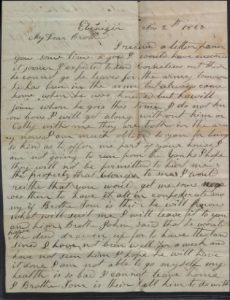After multiple class sessions introducing our archival and manuscript collections and oral history best practices, students in Dr. Nneka Dennie’s Spring 2019 AFR 329: Women & Slavery in the Black Atlantic course produced a documentary using oral histories created throughout the semester. These materials will be donated to the Archives.
In addition to this main project, students were tasked with identifying primary sources from local archives, historic sites, and/or repositories that shed light on the lived experiences of enslaved women or women enslavers. The following series of blog posts are authored by these students upon the completion of this archival research process and serve as reflective pieces.
Thank you for your submissions-and a wonderful semester of fruitful collaborations!
“Primary Source Analysis”
written by Kaitlin Barkley
Archives tell a story through its pictures, diary entries, posters, and assortment of documents. Each curated source, like a puzzle piece, placed together to create a portrait of the past… but often the picture is incomplete. Like a puzzle with missing pieces, the archives often miss important narratives from voices that were marginalized or oppressed at the time. Therefore, although the archives tell a story, the story comes full of biases and half-truths. As an audience knowing this, what do you do with these stories? How do you look at them without falling into its inevitable trap?
Saidiya Hartman in her article “Venus in Two Acts” suggests that the archives, especially those that curate materials on slavery, are inherently violent because of the ways they continue systems of power and oppression. The biggest example of this is the lack, and quite frankly erasure, of enslaved and free women’s voices in the archives. More times than not, there are endless piles of diaries, documents, and pictures of men of varying statuses, occupations and ages. And is compared to the few token materials archives have about women. This stark difference shows the importance placed of the lives and voices of men. Regardless, Hartman suggest that one solution to this inevitable trap is narratives found outside of the archives because they often help supplement the gaps within its archival stories especially about women. Additionally, simply understanding the gaps and limitation of the archives.
Hartman’s words stuck with me as I searched through the archives on slavery in North Carolina, curated by different institutions around the country. To be frank, I wasn’t surprised by how difficult it was even to find materials about the home lives of women. Even when using words that stereotypically denoted occupations and social position for women, I only found materials written or about men. Nevertheless, I found two sources that I thought paired well together because of their contrasting content.
The first source was a poster advertising the start of the Mecklenburg Female College. The poster was created by the college in 1867 illustrating the college’s main building, the cost per semester for amenities, and a short paragraph about the purpose and benefits of the college. In the paragraph, the college boasted about being a qualified and “devoted to female education”. This advertisement is contrasted by a correspondence I found between Mary Gibson and her brother Robert Gibson, a Davidson College Board of Trustee. In the letter, she writes to her brother asking him to make a confederate bond so that she can have access to her money in order to purchase two enslaved women.
Both documents are connected to the lives of white women in North Carolina during slavery. The first, about Mecklenburg Female College, is implicitly connected to slavery. It causes us, as an audience, to consider how these young women’s education is being paid for. The latter source, is explicitly connected to enslavement. Yet, both sources help establishes a fuller narrative about the impact of slavery on womanhood in North Carolina.
These two materials are only three years apart…I am left wondering in those three years how many other stories, tied to archival sources, remain undiscovered.


Speak Your Mind